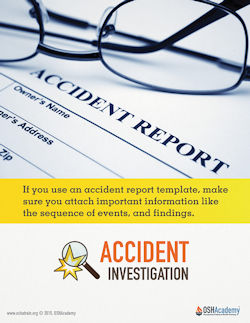Accident Scenario
Step 6. Develop Solutions
Now that the surface and root causes for an accident have been identified, it's time to develop both short-term corrective actions and long-term system improvements that address the causes.
Immediate or short-term corrective actions eliminate or reduce hazardous conditions and/or unsafe practices identified in the investigation. Examples include:
- Install non-slip flooring materials.
- Supply necessary PPE to all employees.
- Repair defective machine guard.
Long-term safety management system improvements create or revise existing safety policies, programs, plans, processes, procedures, and practices identified as missing or inadequate in the investigation.
- Redesign processes to minimize inherent risks.
- Provide thorough training on safety procedures and protocols.
- Establish a proactive preventive maintenance program.
Step 7. Write the Report
Regrettably, many companies opt for simplistic, one-page forms for creating accident reports.
These forms often provide insufficient space for writing the comprehensive reports needed to effectively address both surface and root causes. Most forms leave little room to write the type of detailed report necessary to construct useful reports that address surface and root causes and associated corrective actions and safety management system improvements.
A better idea is to develop a report that includes the following five sections:
Section One - Background Information: This is the who, what, where, when, why, etc. It merely tells who conducted the inspection, when they did it, and who the victim was.
Section Two - Description of the Accident: This section includes the sequence of events you developed. Just take the numbers off and make a nice concise paragraph describing the events leading up to, including the accident.
Section Three - Findings: This section includes a description of the surface and root causes associated with the accident. List the surface causes first and then their associated root causes. Remember, your investigation is to determine the causes, not blame. It's virtually impossible to blame an individual for a workplace accident. Don't let anyone pressure you into placing blame in the report.
Section Four - Recommendations: This section may be part of your report if requested by your employer. Recommendations should relate directly to the surface and root causes of the accident.
It's crucial that, after making recommendations to eliminate or reduce the surface causes, you use the same procedure to recommend actions to correct the root causes. If you fail to do this, it's a sure bet that similar accidents will continue to occur.
Section Five - Summary: In this final section, it's important to present a cost-benefit analysis. The decision-maker should know the total accident costs and the benefits of taking corrective action. The total costs would be the potential future direct and indirect costs if a similar accident were to occur. Compare the total accident costs with the investment in taking corrective actions.
Below is an abbreviated example of an accident report using this format. An actual report would, of course, be much more comprehensive.
Accident Report
Section One - Background Information
An investigation of the workplace accident was conducted on January 5, 2024, by the safety officer, John Doe. The accident involved employee Mark Smith, who was injured at XYZ Corporation's main office located at 123 Business Lane. The incident occurred at approximately 2:00 PM on January 4, 2024, while Mr. Smith was changing a ceiling light bulb.
Section Two - Description of the Accident
Mark Smith was replacing a ceiling light bulb using an old wooden ladder. He had successfully climbed to the top rung of the ladder and was in the process of changing the bulb when the ladder unexpectedly broke. The breakage of the ladder caused Mr. Smith to fall approximately eight feet to the concrete floor below, resulting in a severe leg injury. Colleagues immediately called for medical assistance, and Mr. Smith was transported to the local hospital for treatment.
Section Three - Findings
Surface Causes:
- The ladder used was old and in a state of disrepair.
- The ladder broke while being used, leading to the fall.
Root Causes:
- The company's equipment inspection and maintenance program failed to identify and decommission the old, unsafe ladder.
- There was a lack of proper supervision and enforcement of safety protocols regarding the use and regular inspection of workplace equipment.
Section Four - Recommendations
To address the surface causes:
- Conduct a thorough inspection of all ladders and other equipment used by employees for safety hazards.
- Remove and replace any equipment found to be in disrepair or unsafe.
To address the root causes:
- Implement a regular maintenance and inspection schedule for all workplace equipment.
- Conduct regular training sessions for employees and supervisors on workplace safety protocols and the importance of using safe, well-maintained equipment.
- Establish a clear reporting system for employees to report unsafe conditions or equipment.
Section Five - Summary
The total direct costs of the accident, including medical expenses and workers' compensation, amount to approximately $20,000. Indirect costs, such as lost productivity, training replacement staff, and potential increases in insurance premiums, could amount to an additional $30,000. The recommended corrective actions, including the purchase of new ladders, implementation of an equipment maintenance program, and safety training for staff, are estimated to cost $10,000.
By investing $10,000 in corrective actions, the company can prevent potential future costs of $50,000, resulting from similar accidents. Moreover, implementing these measures will enhance workplace safety and potentially improve employee morale and productivity, providing additional indirect benefits to the company. Therefore, the cost-benefit analysis strongly favors taking the recommended corrective actions to prevent similar incidents in the future.
Knowledge Check Choose the best answer for the question.
6-9. What will happen if you fail to correct the root causes of an accident?
You forgot to answer the question!

